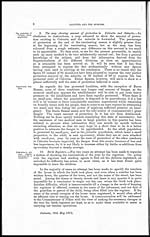Medicine - Vaccination > 1869-1873 - Report on vaccination in the Province of Bengal > Report on vaccination in the Province of Bengal for the year ending 31st March 1872
(240) Page 5
Download files
Individual page:
Thumbnail gallery: Grid view | List view

CALCUTTA AND THE SUBURBS. 5
Out of 2,969 houses examined in the middle division in 1869, the large number
of 20.34 per cent. refused all information: of the others, 45.15 per cent. admitted
vaccination as being the protection enjoyed by the household; 28.20 per cent.
claimed inoculation as being the protecting agent; 26.63 per cent. reported
having had small-pox.
In the north division, out of 2,974 houses in which an investigation was
attempted in 1869, there were 23.13 per cent. in which information was refused;
while of the others 51.70 per cent. admitted vaccination had been accepted in
the house, 32.50 per cent. had received protection by inoculation, 15.79 per cent.
by previous small-pox.
Result of a vaccine
census of schools.
8. Results obtained by the examination of schools.—While having been foiled in
all attempts hitherto made to obtain any precise information regarding the
exact amount and kind of protection enjoyed by the population in general,
useful details with regard to the younger generation, as furnished by a medical
inspection of the pupils attending various schools, have been from time to time
collected and stored in the records of this office, both with the view of guid-
ing present work, and as a standard of comparison to test the work of future
years. The data now supplied are trustworthy, as they have been collected by
the Superintendents themselves, and represent the result of actual inspection.
In 1869.
Much more detailed information is preserved in this office, but, as it is
considered that the gross results alone are of interest for the purposes of this
report, it is not furnished for the present. Out of 7,871 pupils examined,
the majority of whom were between the ages of 10 and 18 years in
the year 1869, 37.65 per cent. were found to have been vaccinated, 45.10
per cent. to have been inoculated, 10.71 per cent. to have had small-pox,
while 6.53 remained without any form of protection. As many of those
examined were not born in Calcutta, their form of protection depends on
that followed in the district in which they previously resided. It is proposed
after the lapse of five years again to make a similar investigation, as a yearly one
is not desirable, for it interferes so much with the work of the schools, as to be
resented by the teachers Even on the first, but more so on the second, repeti-
tion of the inquiry a most marked change will doubtless be brought to light
in the displacement of inoculation by vaccination, and in the diminution of the
percentage of both the classes of those having had small-pox and remaining
unprotected—(see Appendix C).
Patshalas.
The patshalas (rudimentary schools), in which the ages of most of the
children range between 7 amd 9 years, are yearly inspected as a means of
searching out unprotected children, and as one way of introducing vaccination
into the houses of those thus detected as not having received protection. Out
of 846 children examined in 1869, 43.14 per cent. were found to have been
vaccinated, 19.38 per cent. to have been inoculated, 19.97 to have had small-pox,
and 17.49 to be without protection. In 1870, 2,050 children were examined ;
of these 43.95 per cent. were vaccinated, 19.41 per cent. inoculated, 24.19 per
cent. marked by small-pox, while 12.41 per cent. enjoyed no form of protection.
Yearly increase of
the proportion
of vaccinated
children.
In 1871 the number of children inspected amounted to 1,750; 57.48 per
cent. had been vaccinated, 26.17 per cent. had been inoculated, 13.94 only had
had small-pox, and only 8.40 per cent. remained unprotected. In the same
way, as the results of the examination of 2,145 children in 1872, 61.63 per cent.
have been found protected by vaccination, 15.47 per cent. by inoculation,
15.38 per cent. by previous small-pox, while only 7.5 per cent. have received
no form of protection. Year by year the increase of vaccinated children
already noticeable will continue, while the numbers protected by small-
pox will gradually disappear, and the number unprotected will be considerably
diminished. As these changes will take very few years to declare themselves,
the evidence they will afford will be extremely satisfactory, and the labor
entailed by the investigation will be amply repaid.
Subjoined is a form which shows the above facts in a tabular statement—
(see appendix D).
2
Set display mode to: Large image | Zoom image | Transcription
Images and transcriptions on this page, including medium image downloads, may be used under the Creative Commons Attribution 4.0 International Licence unless otherwise stated. ![]()
| India Papers > Medicine - Vaccination > Report on vaccination in the Province of Bengal > Report on vaccination in the Province of Bengal for the year ending 31st March 1872 > (240) Page 5 |
|---|
| Permanent URL | https://digital.nls.uk/91535343 |
|---|
| Additional NLS resources: | |
|---|---|




